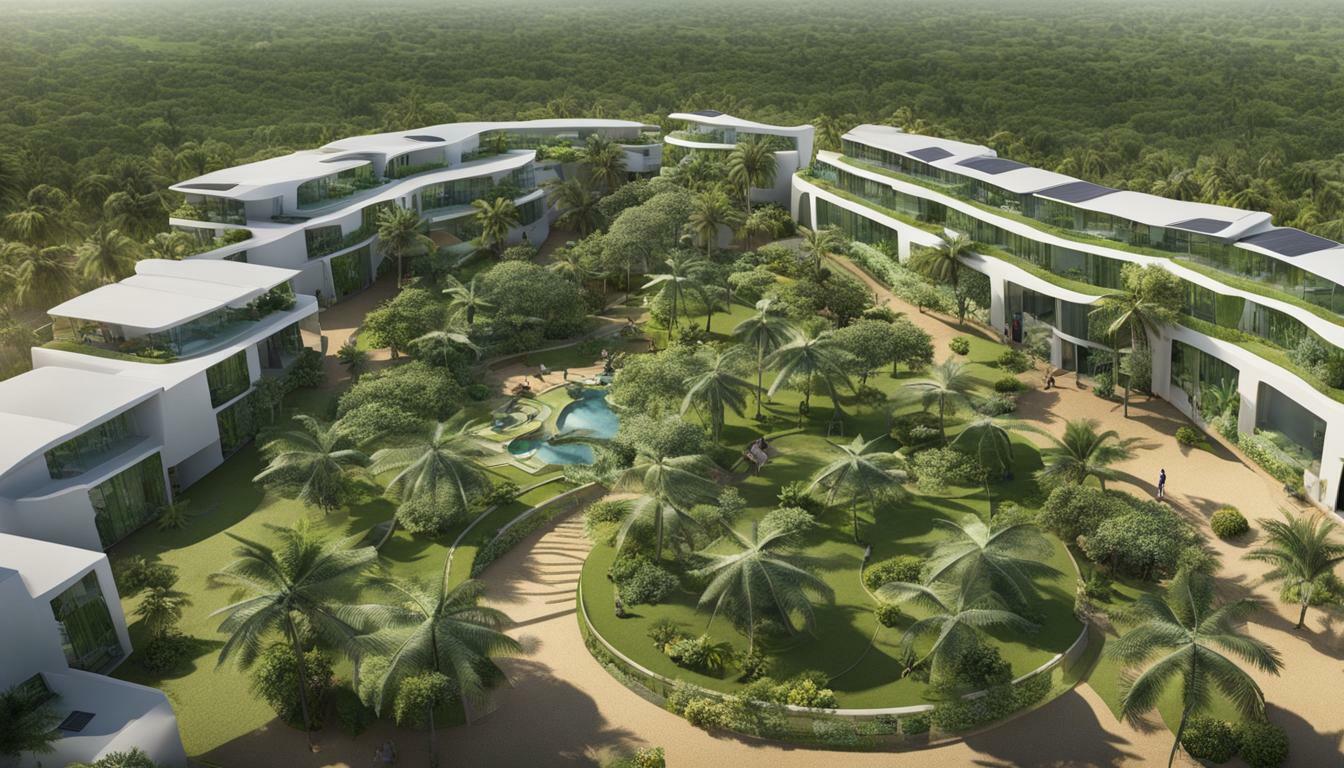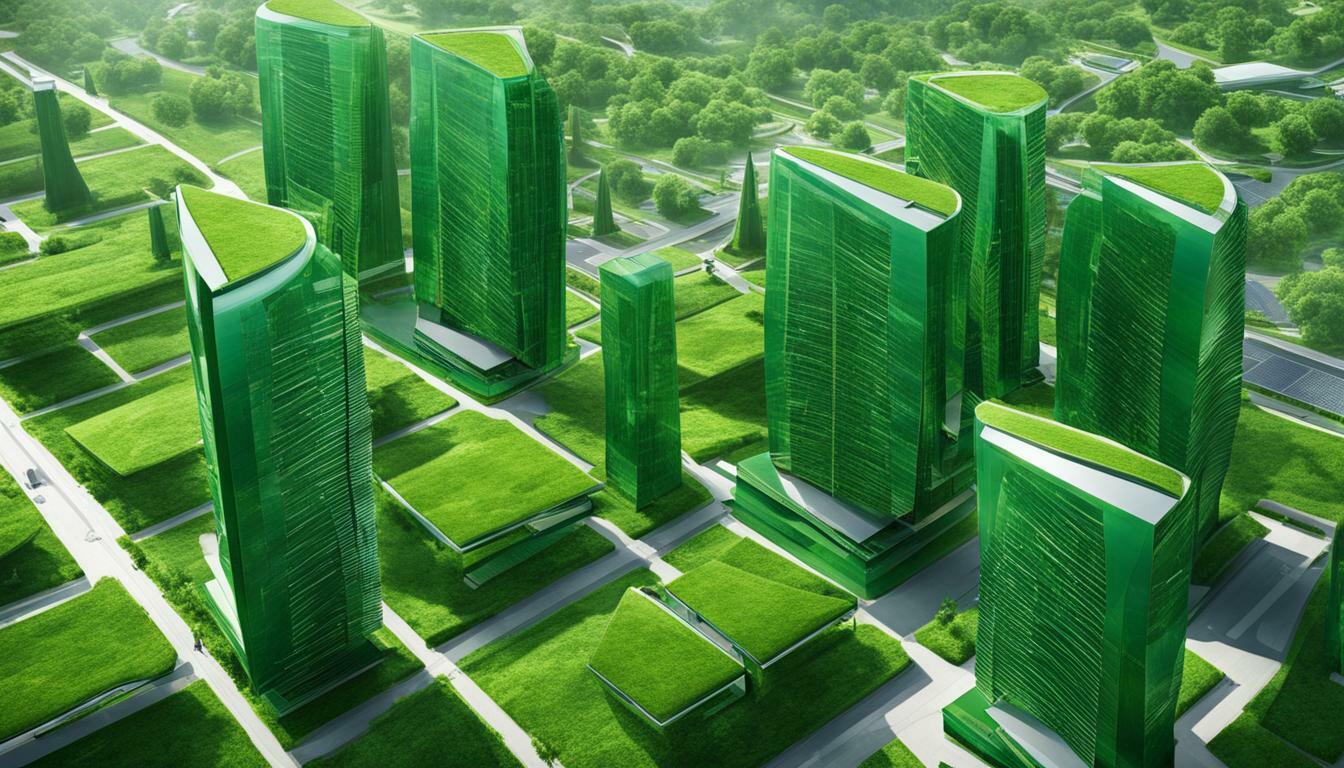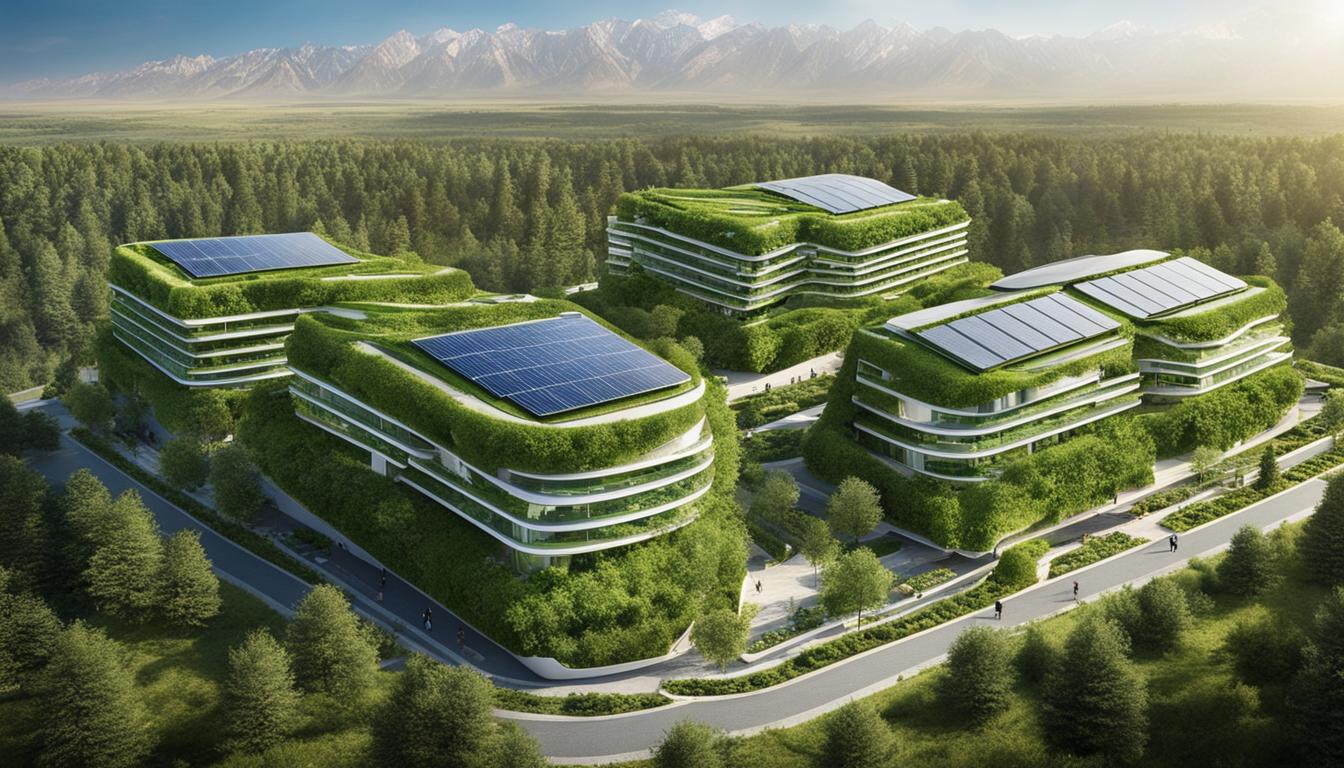El Salvador Top Green Buildings
El Salvador is home to some of the most impressive green buildings in Central America, showcasing sustainable architecture and environmentally conscious design. The emergence of the El Salvador Green Building Council (El Salvador GBC) has played a significant role in promoting green building practices and raising awareness about the importance of eco-friendly construction in the country.
Under the guidance of the El Salvador GBC, architects and builders have been inspired to incorporate green features in their designs, leading to the creation of environmentally friendly structures that harmonize with the natural environment.
Key Takeaways:
- El Salvador has a thriving green building sector, showcasing sustainable architecture and eco-friendly construction practices.
- The El Salvador Green Building Council has played a crucial role in promoting green buildings and providing education and resources to the market.
- Architect José Roberto Paredes has designed a unique green home in La Libertad, El Salvador, which combines modern design with sustainable materials and features.
- Green buildings in El Salvador prioritize energy efficiency, water conservation, and the use of renewable resources.
- Living in harmony with nature is a central theme in the design and construction of green buildings, with features like green roofs and ample daylight.
The Emergence of El Salvador Green Building Council
The El Salvador Green Building Council (El Salvador GBC) has emerged as a driving force in promoting environmentally conscious design and green building practices in the country. Recognized by the World Green Building Council, the council has taken significant steps towards educating the market and fostering collective action in sustainable building. Their commitment to scaling up their impact has been met with enthusiasm from the council’s chair, Juan Francisco Sifontes.

In addition to the council’s efforts, architect José Roberto Paredes has made a significant contribution to sustainable building in El Salvador. His unique green home, located in the municipality of La Libertad, showcases an innovative approach to design that prioritizes the connection to the natural environment. The freestanding concrete roof envelops the structure, providing protection from the elements, while materials such as rough-hewn stone and reclaimed building materials blend harmoniously with the surroundings.
The green home incorporates various eco-friendly features, including rainwater harvesting, passive cooling techniques, LED bulbs, and rooftop hookups for solar panels. The design aims to immerse residents in nature, with abundant daylight and views of the outdoors. The integration of traditional elements, modern design, and green technologies has resulted in an inspiring and sustainable living space for the Escobar family.
| Features of José Roberto Paredes’ Green Home |
|---|
| Rainwater harvesting |
| Passive cooling techniques |
| LED bulbs |
| Rooftop hookups for solar panels |
Living in Harmony with Nature
The emphasis on sustainable design extends beyond Paredes’ green home to El Salvador’s commitment to environmentally friendly architecture. The country’s top green buildings showcase the integration of green roof technology, which allows for the cultivation of vegetation on rooftops, providing numerous benefits such as improved insulation and biodiversity. Furthermore, the incorporation of ample windows and strategic positioning of the living space offers breathtaking views of the outdoors, reinforcing the connection to nature.
“El Salvador’s top green buildings demonstrate the country’s commitment to sustainable and environmentally friendly architecture.”
El Salvador is paving the way for sustainable architecture with the El Salvador Green Building Council leading the charge. Through their advocacy and initiatives, the council and green architects like José Roberto Paredes are transforming the landscape of construction in the country, creating a more sustainable and eco-friendly future.
Architect José Roberto Paredes’ Unique Green Home
Architect José Roberto Paredes has created a stunning green home in the municipality of La Libertad, showcasing his expertise in sustainable architecture and use of green building materials. This unique residence harmoniously blends nature, tradition, modern design, and green technologies to create a truly inspiring living space.
The house’s standout feature is its freestanding concrete roof that wraps around the structure, providing protection from the elements while enhancing its connection to the natural environment. The roof’s design allows for ample daylight and offers panoramic views of the surrounding landscape, creating a sense of living in the garden.
To maintain a sustainable footprint, Paredes incorporated a range of environmentally friendly elements. The house utilizes rainwater harvesting systems to collect and store water, reducing reliance on external sources. Passive cooling techniques, such as strategic placement of windows and ventilation, help regulate temperature naturally, minimizing the need for artificial cooling. The use of energy-efficient LED bulbs further contributes to the home’s eco-conscious design.
Furthermore, the house is equipped with rooftop hookups for solar panels, providing an opportunity to harness renewable energy and reduce reliance on the electrical grid. The combination of these green features ensures that the residence not only minimizes its environmental impact but also offers long-term energy savings for its occupants.
The Escobar Family’s Green Haven
“We wanted a home that would embrace nature and reflect our commitment to sustainable living. José Roberto Paredes’ design exceeded our expectations, providing a unique blend of comfort, functionality, and environmental consciousness,” said Mr. Escobar, the homeowner.
The materials used in the construction of the house also contribute to its sustainable nature. Paredes opted for locally sourced rough-hewn stone and reclaimed building materials, reducing the carbon footprint associated with transportation and minimizing waste. This conscious choice not only adds a touch of authenticity but also integrates the house seamlessly into its natural surroundings.
Architect José Roberto Paredes’ green home in La Libertad serves as a testament to El Salvador’s commitment to sustainable architecture and eco-friendly construction practices. It exemplifies how thoughtful design, the use of green building materials, and the incorporation of sustainable technologies can create a harmonious living space that respects both nature and tradition.
| Key Features of José Roberto Paredes’ Green Home: |
|---|
| Freestanding concrete roof that enhances the connection to nature |
| Ample daylight and panoramic views of the outdoors |
| Rainwater harvesting system for water conservation |
| Passive cooling techniques for natural temperature regulation |
| Energy-efficient LED bulbs for reduced electricity consumption |
| Rooftop hookups for solar panels to harness renewable energy |
| Use of locally sourced rough-hewn stone and reclaimed building materials |

Paredes’ green home incorporates a range of eco-friendly features, including rainwater harvesting systems, passive cooling techniques, and energy-efficient LED bulbs. These elements not only contribute to the sustainability of the house but also provide a comfortable and environmentally conscious living environment for the Escobar family.
“We wanted to create a home that not only respects nature but also utilizes its resources wisely,” explained architect José Roberto Paredes. “By incorporating green features into the design, we were able to achieve a harmonious blend of modern architecture and eco-friendly living.”
The rainwater harvesting systems installed in the house allow for the collection and storage of rainwater, which can then be used for various purposes such as irrigation and flushing toilets. This reduces the reliance on traditional water sources and promotes water conservation.
Passive cooling techniques, such as strategic placement of windows for cross ventilation and the use of shading devices, help maintain a comfortable indoor temperature without the need for excessive energy consumption. These techniques take advantage of natural airflow and reduce the reliance on air conditioning systems, resulting in energy savings and a reduced carbon footprint.
To further enhance energy efficiency, the house is equipped with LED bulbs throughout. LED bulbs are known for their low energy consumption and longer lifespan compared to traditional incandescent bulbs. This not only reduces energy costs but also contributes to reducing greenhouse gas emissions.

| Green Features | Benefits |
|---|---|
| Rainwater Harvesting System | – Reduces reliance on traditional water sources – Promotes water conservation – Cost-effective solution |
| Passive Cooling Techniques | – Reduces energy consumption – Provides a comfortable indoor temperature – Minimizes reliance on air conditioning systems |
| LED Bulbs | – Low energy consumption – Longer lifespan – Reduced greenhouse gas emissions – Cost-effective lighting solution |
Living in Harmony with Nature
The green home designed by José Roberto Paredes aims to create a seamless connection to the natural environment, with green roof technology, generous daylight, and breathtaking views of the surrounding landscape. Paredes’ innovative design concept merges nature and architecture, allowing the homeowners to feel immersed in the beauty of their surroundings.
One of the standout features of the green home is its green roof technology. This design element involves covering the roof with vegetation, providing insulation, reducing energy consumption, and improving air quality. The lush greenery not only adds visual appeal but also creates a natural cooling effect, minimizing the need for artificial cooling systems.
Moreover, the design incorporates large windows and open spaces to maximize the use of natural light. The abundant daylight not only reduces the need for artificial lighting but also creates a vibrant and inviting atmosphere inside the home. The strategically placed windows offer breathtaking views of the outdoors, allowing the residents to connect with nature and enjoy the picturesque landscape.
To further enhance the residents’ connection to nature, the green home features outdoor living spaces that seamlessly blend with the interior. These spaces provide opportunities for relaxation and enjoyment, allowing the occupants to experience the serenity of the natural environment. Whether it’s a cozy patio surrounded by lush vegetation or a spacious terrace with panoramic views, these outdoor areas truly embody the concept of harmonious living.

| Features of the Green Home | Benefits |
|---|---|
| Green roof technology | – Insulation |
| – Reduced energy consumption | |
| – Improved air quality | |
| Generous daylight | – Reduced need for artificial lighting |
| – Vibrant and inviting atmosphere | |
| Breathtaking views | – Connection with nature |
| – Enjoyment of the picturesque landscape |
The green home designed by José Roberto Paredes is a perfect example of how sustainable architecture can seamlessly blend with nature. By incorporating green roof technology, maximizing natural light, and providing breathtaking views, the design creates a harmonious and inspiring living space. It serves as a testament to El Salvador’s commitment to sustainable and environmentally friendly architecture.
El Salvador’s Commitment to Sustainable Architecture
El Salvador’s dedication to sustainable architecture is evident through the numerous green buildings and the active role played by the El Salvador Green Building Council (El Salvador GBC) in promoting environmentally friendly design and construction practices. The council, recognized by the World Green Building Council, has become a driving force in the country’s sustainable building movement. It aims to educate the market, act as a source of information, and encourage collective action in sustainable building.
The chair of the El Salvador GBC, Juan Francisco Sifontes, expressed delight at the council’s progress and their commitment to scaling up their impact in the country. Through their efforts, they have successfully raised awareness of the importance of sustainable architecture and have facilitated the implementation of green building practices across El Salvador.
One remarkable example of sustainable architecture in El Salvador is the unique green home designed by architect José Roberto Paredes in the municipality of La Libertad. Paredes’s design focuses on the connection between the house and its natural surroundings. The house features a freestanding concrete roof that wraps around the structure, providing protection from the elements while blending harmoniously with the environment.
This green home incorporates various sustainable features, including rainwater harvesting, passive cooling techniques, LED bulbs, and rooftop hookups for solar panels. The design aims to create a sense of living in the garden, with ample daylight and stunning views of the outdoors. Paredes’s use of eco-friendly materials, such as rough-hewn stone and reclaimed building materials, further enhances the home’s sustainable footprint.
El Salvador’s commitment to sustainable architecture is commendable, as it not only showcases the country’s dedication to preserving the environment but also encourages others to adopt eco-friendly design and construction practices. Through the collaborative efforts of the El Salvador GBC and innovative architects like José Roberto Paredes, the future of sustainable building in El Salvador looks promising.

| Key Features of El Salvador’s Sustainable Architecture |
|---|
| Active role of the El Salvador Green Building Council in promoting sustainable building practices |
| Unique green home design by architect José Roberto Paredes |
| Focus on sustainable materials and incorporating eco-friendly features |
| Connection to the natural environment through green roof technology and ample daylight |
Conclusion
El Salvador’s top green buildings serve as inspiring examples of sustainable architecture and highlight the country’s commitment to eco-friendly construction practices. With the emergence of the El Salvador Green Building Council (El Salvador GBC), the country has made significant progress in promoting green buildings.
Recognized by the World Green Building Council, the El Salvador GBC has become a driving force in educating the market and fostering collective action in sustainable building. Led by chair Juan Francisco Sifontes, the council is dedicated to scaling up their impact and further advancing green building practices in the country.
Architect José Roberto Paredes has also contributed to the sustainable building movement with his unique green home in La Libertad. The house showcases a seamless connection to the natural environment, featuring a freestanding concrete roof that envelops the structure, providing protection from the elements.
Paredes intentionally used materials that harmonize with the surroundings, incorporating rough-hewn stone and reclaimed building materials. The green home incorporates various environmentally friendly features, including rainwater harvesting, passive cooling, LED bulbs, and rooftop hookups for solar panels.
Designed to immerse inhabitants in nature, the home maximizes natural light and offers captivating views of the outdoors. Blending tradition, modern design, and green technologies, it provides a unique and inspiring living space for the Escobar family.
In essence, El Salvador’s commitment to sustainable and environmentally friendly architecture is evident in its top green buildings. From the efforts of the El Salvador GBC to the innovative designs of architects like José Roberto Paredes, the country is paving the way for a greener future.
FAQ
What are the top green buildings in El Salvador?
El Salvador has several top green buildings that showcase sustainable architecture and eco-friendly construction practices. One notable example is the unique green home designed by architect José Roberto Paredes in the municipality of La Libertad.
What is the role of the El Salvador Green Building Council?
The El Salvador Green Building Council plays a vital role in promoting green building practices and energy-efficient infrastructure in the country. They educate the market, act as a source of information, and facilitate collective action in sustainable building.
Can you tell me more about architect José Roberto Paredes’ green home?
Architect José Roberto Paredes has designed a unique green home in La Libertad, El Salvador. The house features a freestanding concrete roof that wraps around the structure and shields it from the elements. Paredes used materials that blend with the surroundings, such as rough-hewn stone and reclaimed building materials.
What are some of the green features incorporated in the design of the green home?
The green home designed by architect José Roberto Paredes incorporates various green features, including rainwater harvesting, passive cooling techniques, the use of LED bulbs, and rooftop hookups for solar panels.
How does the design create a connection to the natural environment?
The design of the green home focuses on creating a sense of living in harmony with nature. It includes green roof technology, ample daylight, and views of the outdoors, allowing residents to feel connected to the natural environment.
What does El Salvador’s commitment to sustainable architecture entail?
El Salvador’s commitment to sustainable architecture involves promoting environmentally friendly building practices and sustainable construction methods. The efforts of the El Salvador Green Building Council play a significant role in driving this commitment forward.
Why are El Salvador’s top green buildings important?
El Salvador’s top green buildings are essential in showcasing sustainable architecture and eco-friendly construction practices. They demonstrate the country’s dedication to addressing environmental concerns and creating a more sustainable future.
Source Links
- https://worldgbc.org/article/el-salvador-green-building-council-and-paraguay-green-building-council-progress-to-emerging-members-of-worldgbc/
- https://www.dwell.com/article/striking-green-house-with-a-view-in-el-salvador-bef452bc
- https://www.tripadvisor.com/Attractions-g294475-Activities-c47-t3-El_Salvador.html








